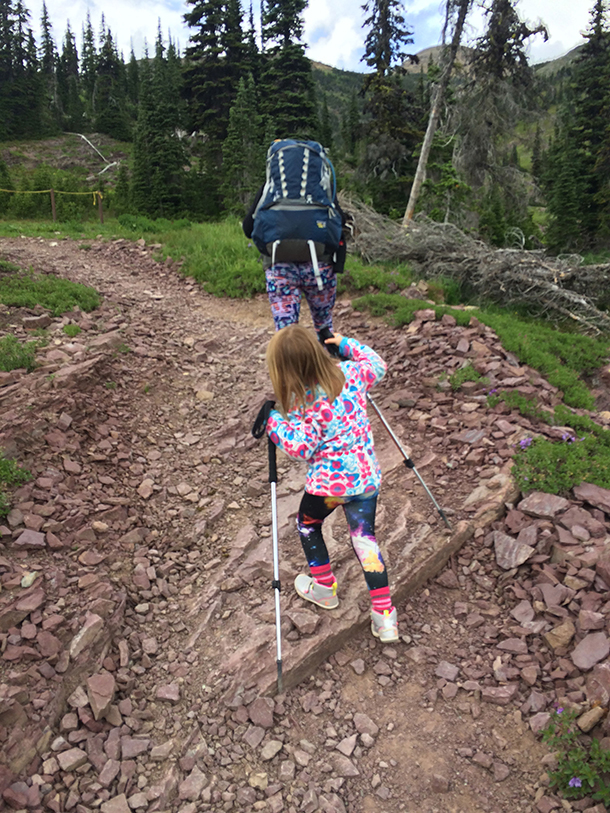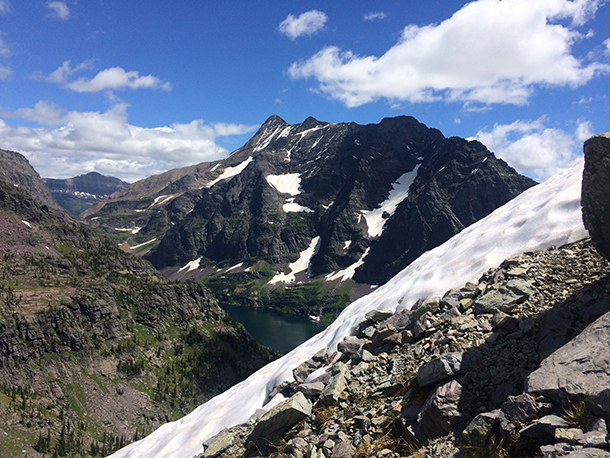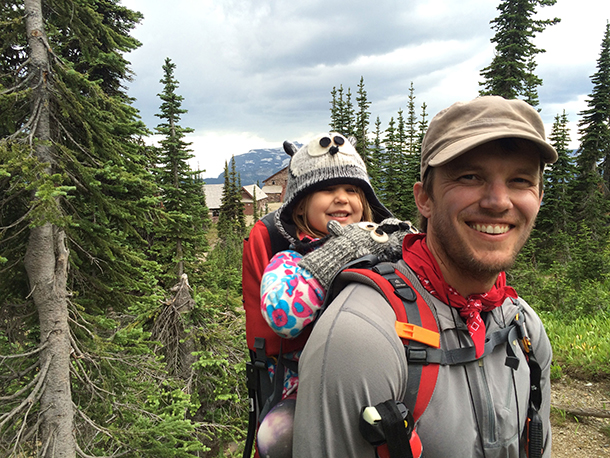The Place Where You Live: Glacier National Park
Air Date: Week of November 9, 2018

From his perch at Siyeh Pass, Bjorn can see the Great Plains begin at the edge of Glacier National Park. (Photo: courtesy of Bjorn Beer)
Software executive and writer Björn Beer describes the breathtaking beauty of Montana’s Glacier National Park and mourns the impending loss of the park's namesakes. It's the latest installment in Living on Earth's collaboration with Orion magazine that gives a voice to Orion's longtime feature in which readers write about the places they call home.
Transcript
CURWOOD: We head to Montana, Ryan Zinke’s home state, for a look at some of the effects of climate change expected by 2030, for another installment in the occasional Living on Earth/Orion Magazine series, “The Place Where You Live.” Orion invites readers to submit essays to the magazine’s website and put their homes on the map, and we give them a voice.
[MUSIC: Edward Sharpe and The Magnetic Zeroes “Home” from Edward Sharpe and The Magnetic Zeroes (Rough Trade Records 2009)]
BEER: My name is Bjorn Beer, and this is my essay on Glacier National Park.
Last summer I stood with my wife on the edge of a sheer cliff in Glacier National Park. We stared down towards the massive Grinnell Glacier. In that moment we decided to move to Montana. I can work anywhere with internet, and my wife had multiple job offers at hospitals across the country. We could have picked anywhere, but we decided to make this remote region our home, the center of our universe.

Freya and Mom taking the first steps on a steep side trip up to Swiftcurrent Pass. (Photo: Bjorn Beer)
[MUSIC: UNDER BEER’S NARRATION: BRIAN ENO, “ARAGON,” MUSIC FOR FILMS, https://www.youtube.com/watch?v=q5VIJor61uM]
As a writer, I’m surprised that I can’t find the exact words to explain why we chose to live in the Flathead Valley. Perhaps it’s the fact we’ll be on the largest freshwater lake west of the Mississippi, a definite advantage as the West becomes hotter and drier. Or maybe the proximity to the raw, jagged beauty of Glacier Park lifts my soul. Perhaps we were just drawn to the great skiing, hoping our daughter can experience this privileged pastime, as the autumn lingers longer, and spring accelerates bit by bit, year by year. I can’t tell you one rational reason why we chose Montana, so perhaps the rationale lies deeper, in emotion, in loss.
By the year 2030, all of these glaciers will be gone.
[SOUNDS OF TRICKLING WATER MIX WITH MUSIC UNDER BEER’S NARRATION: BRIAN ENO, “ARAGON,” MUSIC FOR FILMS, https://www.youtube.com/watch?v=q5VIJor61uM]
Blackfoot, Jackson, Sperry, Swiftcurrent, Grinnell, and dozens more. Their stately names will disappear as they melt and flow into the sea. Perhaps there is some guilt here, like the way we might not see a relative for years, but once she is on her deathbed, we feel compelled to visit, to commune, to see her before she loses her earthly form.
I want to be there as they melt. I want to hike back to Grinnell Glacier with my then teenage daughter in the year 2030 as the last sliver of ice sublimates into human memory. I will want to say, “I’m sorry.” I will want to say, “We tried.”
We were here last summer on an interview that my wife had here at the hospital. She was looking for jobs around the country, and we went up into the park on a very epic hike called the Highline trail. It starts off at a high pass.

Bjorn, Amanda, and Freya Beer headed along the scenic Highline Trail en route to a night in the backcountry. (Photo: courtesy of Bjorn Beer)
[SOUND OF FOOTSTEPS]
And we ended hiking up to this ridge that overlooked this glacier, and it was just a tremendous experience. Climbing up this scree field, just a bunch of small stones that are a little bit hard footing on, a steep, steep trail up, you climb and climb for about 45 minutes, and the view that surprises you on the other side, you’re not expecting it but you can see Grinnell glacier a couple thousand feet below you and it just takes your breath away. It's this glacier that is calving off into Grinnell Lake. The water is this very bright, bright blue. It's just this amazing turquoise that provides this very stark contrast against the white glacier on these very dark cliffs, blue sky that, of course, we're in big sky country so you can see pretty far.
[MUSIC UNDER NARRATION CONTINUES]
What I love about wilderness like this is it so humbling, and Glacier Park in particular is exceptionally humbling because you have these very large animals that can potentially eat you, and the weather is incredibly extreme here, so you have to be prepared for anything, even a day hike you have to be prepared. We tried to hike up to the same overlook a couple weeks ago with our daughter, she's three-and-a-half and she was riding on my back.

View from Lincoln Peak of glaciers on west side of Mount Jackson, which feed Lake Ellen Wilson. Permanent snowfield in foreground was used to test out Bjorn's new ice axe. (Photo: Bjorn Beer)
[SOUNDS OF THUNDER]
On the way to this hike, we couldn't actually summit because of a lightning storm, so we turned back around and stayed at a chalet that night and the next day we said, “Let's go up and show our daughter the Grinnell Glacier Overlook.” And there was a grizzly sow and its cub that were on the trail head up to this overlook so we ended up having to walk out with a ranger to avoid the grizzly.
[MUSIC CONTINUES UNDER NARRATION.]
It's hard to wrap your mind around when you're standing next to or above this glacier that in just a few decades it might be gone in the blink of an eye. Back in the 1800s, there were about 150 active glaciers. Today it's down to 25. Some people are saying that by the year 2030 all of these glaciers will be gone. At this northern latitude and with the glaciers, we're seeing the effects of climate change happen much faster in this part of the world. You do feel like you're almost a canary in a coal mine living here.
[TALKING TO HIS DAUGHTER] What we're going to do here, Freya, is we're going to record your beautiful song so that I can learn to sing.

Bjorn and Freya Beer climbing up to Swiftcurrent Pass from the backcountry Granite Park Chalet in Glacier National Park. (Photo: courtesy of Bjorn Beer)
FREYA: OK. [SINGS] The Earth is good to me, and so I thank the Earth for giving me the things I need, the sun and the rain and the appleseeds. The Earth is good to me.
[MUSIC: "Johnny Appleseed," Instrumental piano recording arr. Bernie Cossentino for SongsForTeachers ]
CURWOOD: That’s Bjorn Beer’s three-year-old daughter, Freya, and his essay on Grinnell Glacier. There are pictures at our website, LOE.org, and there you’ll also find details about Orion Magazine and how to submit your essay, if you want to tell us about the place where you live.
Links
Climate Change in Glacier National Park
National Geographic Video: Photo Evidence: Glacier National Park is Melting Away
Living on Earth wants to hear from you!
Living on Earth
62 Calef Highway, Suite 212
Lee, NH 03861
Telephone: 617-287-4121
E-mail: comments@loe.org
Newsletter [Click here]
Donate to Living on Earth!
Living on Earth is an independent media program and relies entirely on contributions from listeners and institutions supporting public service. Please donate now to preserve an independent environmental voice.
NewsletterLiving on Earth offers a weekly delivery of the show's rundown to your mailbox. Sign up for our newsletter today!
 Sailors For The Sea: Be the change you want to sea.
Sailors For The Sea: Be the change you want to sea.
 The Grantham Foundation for the Protection of the Environment: Committed to protecting and improving the health of the global environment.
The Grantham Foundation for the Protection of the Environment: Committed to protecting and improving the health of the global environment.
 Contribute to Living on Earth and receive, as our gift to you, an archival print of one of Mark Seth Lender's extraordinary wildlife photographs. Follow the link to see Mark's current collection of photographs.
Contribute to Living on Earth and receive, as our gift to you, an archival print of one of Mark Seth Lender's extraordinary wildlife photographs. Follow the link to see Mark's current collection of photographs.
 Buy a signed copy of Mark Seth Lender's book Smeagull the Seagull & support Living on Earth
Buy a signed copy of Mark Seth Lender's book Smeagull the Seagull & support Living on Earth

